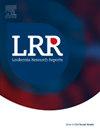Tyrosine kinase inhibitors modulate the expression of peroxiredoxins 1 and 2 in chronic myeloid leukemia cells
IF 0.9
Q4 HEMATOLOGY
引用次数: 0
Abstract
Chronic myeloid leukemia (CML) is characterized by the presence of the BCR::ABL1 fusion protein with active tyrosine kinase activity. The BCR::ABL1 fusion protein induces the production of reactive oxygen species (ROS). DNA damage caused by ROS is involved in the mechanism of CML progression. Antioxidant systems include peroxiredoxins (PRDXs), which play various roles in hematological malignancies. Although tyrosine kinase inhibitors (TKIs) are known to affect ROS production, their effects on the expression of the antioxidants PRDX1 and PRDX2 remain unclear; thus, we aimed to evaluate the effects of TKIs on the expression of these PRDXs and ROS levels in CML cells. We found that TKIs, such as imatinib, nilotinib, and dasatinib, increased the gene expression of PRDX2 in K562 cells; however, only dasatinib increased the cytoplasmic protein expression of PRDX2. Additionally, while TKIs reduced the gene expression of PRDX1 in contrast to that of PRDX2, dasatinib increased the cytoplasmic protein expression of PRDX1. This discrepancy was linked to post-translational regulation through SUMOylation in cooperation with dasatinib. Our results suggest that the antioxidants PRDX1 and PRDX2 could serve as potential targets for TKIs in the treatment of CML.
酪氨酸激酶抑制剂调节慢性髓性白血病细胞中过氧化物还毒素1和2的表达
慢性髓性白血病(CML)的特点是存在具有活跃酪氨酸激酶活性的BCR::ABL1融合蛋白。BCR::ABL1融合蛋白诱导活性氧(ROS)的产生。由ROS引起的DNA损伤参与了CML进展的机制。抗氧化系统包括在血液系统恶性肿瘤中发挥多种作用的过氧化物还毒素(PRDXs)。虽然已知酪氨酸激酶抑制剂(TKIs)会影响ROS的产生,但它们对抗氧化剂PRDX1和PRDX2表达的影响尚不清楚;因此,我们旨在评估TKIs对CML细胞中这些PRDXs表达和ROS水平的影响。我们发现TKIs,如伊马替尼、尼罗替尼和达沙替尼,增加了K562细胞中PRDX2的基因表达;然而,只有达沙替尼增加了PRDX2的细胞质蛋白表达。此外,与PRDX2相比,TKIs降低了PRDX1的基因表达,而达沙替尼增加了PRDX1的细胞质蛋白表达。这种差异与通过SUMOylation与达沙替尼合作进行的翻译后调节有关。我们的研究结果表明,抗氧化剂PRDX1和PRDX2可能是TKIs治疗CML的潜在靶点。
本文章由计算机程序翻译,如有差异,请以英文原文为准。
求助全文
约1分钟内获得全文
求助全文

 求助内容:
求助内容: 应助结果提醒方式:
应助结果提醒方式:


